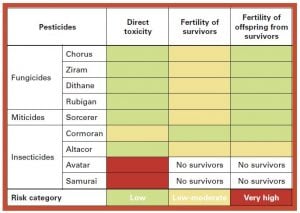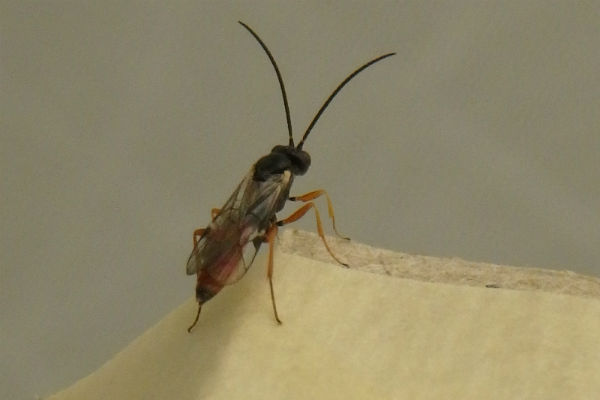Changes to the types of pesticide available for use in fruit production, and the progress of research into biological control of major insect pests, are providing fruit growers with safer, more cost-effective and environmentally-friendly options to incorporate into their pest management systems.
Codling moth is the most serious pest of pome fruit worldwide and the most damaging pest of commercial apple, pear, quince and nashi orchards in Australia. It is widely distributed in all
Australian states except Western Australia and the Northern Territory. In the past, codling moth was controlled by multiple applications of organophosphate insecticides until the pest
developed resistance to the pesticides. Newer pesticides with lower human toxicity are more specific and more expensive than the organophosphate pesticides they replaced, but also require more attention to timing of spray applications and adherence to resistance management strategies.
Codling moth overwinters on pome fruit trees as hibernating mature caterpillars in cocoons in sheltered areas such as under bark scales on the trunk. In spring, as the day-length increases and temperatures warm up, the caterpillars come out of hibernation, enter pupation and eventually emerge as adult moths ready to mate and lay eggs. Mating disruption is designed to reduce or delay mating so that fewer eggs are laid. Sex-pheromone-mediated mating disruption can be an effective alternative to the use of pesticides for control of low to moderate population levels of codling moth. However, control of moderate to high population densities is more problematic and several consecutive seasons of area-wide mating disruption treatments are needed to control higher pest population levels. The aim of mating disruption is to prevent or at least significantly reduce mating between male and female moths but if there are enough female moths present mating can still occur. It is therefore important that fruit growers have access to different tools that can help reduce the number of female moths in their orchards.
New parasitic wasp released
A new biocontrol agent that targets codling moth has been introduced into Australia. This new biological control agent, a wasp called Mastrus ridens, seeks out hibernating codling moth caterpillars and lays eggs in the cocoons. When the wasp eggs hatch the wasp larvae feed on the codling moth caterpillars, killing them. The wasps were introduced into Australia and confined in quarantine until, after five years of host-specificity testing, approval was granted to release them in orchards.
The first release was into an organic orchard in the Goulburn Valley, Victoria, in 2014 to establish a nursery site and to provide a field site in which establishment issues such as dispersal, predation and hyper-parasitism could be studied. Since then the research team has been releasing Mastrus into sites in Queensland, New South Wales, South Australia, Tasmania and
southern Victoria. The team has also been investigating the impacts on wasp survival of commonly used orchard pesticides.
Codling moth larvae consumed by Mastrus are easily distinguished from those that have been consumed by predators, because in the latter case there are generally only scattered remains, if anything is left. The project team confirmed parasitism by Mastrus but there was also considerable predation by earwigs and ants. An added bonus was detection of another wasp, probably Gotra pomonellae, that was also attacking codling moth pupae.
To release Mastrus in orchards, parasitised codling moth larvae in corrugated cardboard bands are transported in chilled eskies, transferred into modified fruit fly traps suspended from the lower limbs of fruit trees, and left until the adult wasps emerge and disperse. Between 8,000 and 20,000 Mastrus were released at each site and Mastrus adults were seen searching the trees for codling moth larvae for about a week after their release.

Effect of different pesticides on Mastrus ridens
New pheromone for traps
Until recently it has been difficult to catch female codling moths in traps. A chemical ester isolated from pears and added to pheromone traps changed that situation in apple orchards but did not perform so well in pear orchards, probably because of competition from the pears themselves. Adding an extra plant volatile to the pheromone-pear ester mixture increased the capture of male and female codling moths in pear orchards treated with mating disruption.
Mass-trapping using the enhanced lure in pear orchards under mating disruption gave excellent control of codling moths. Improved pheromone-mediated mating disruption can help to maintain low codling moth populations when used with other biological control methods. This reduces the need for pesticides that may be toxic to Mastrus ridens. The table indicates the risk of some common pesticides in terms of direct and indirect effects such as fertility of surviving adults and their offspring.
The release of the codling moth parasitoid Mastrus ridens, combined with mass-trapping of codling moth females and the use of mating disruption, will potentially prevent the over-use of insecticide cover sprays and provide effective biocontrol of codling moth in pome fruit.
Acknowledgement
The research into mass-trapping was funded by Hort Innovation using the apple and pear R&D levy, nashi industry contributions and contributions from participating orchardists, plus funding from the Australian Government. The introduction of Mastrus ridens was funded through the Hort Innovation Apple and Pear Fund, using the apple and pear R&D levy, contributions from Plant and Food Research Limited New Zealand and funding from the Australian Government. Likewise, the distribution and establishment of Mastrus ridens is funded through the Hort Innovation Apple and Pear Fund using the industry levy and government contributions. In each of the above projects the Victorian Government provided additional funds, not managed by Hort Innovation, through the Agriculture Victoria Research Division of its Department of Economic Development Jobs Transport and Resources.

